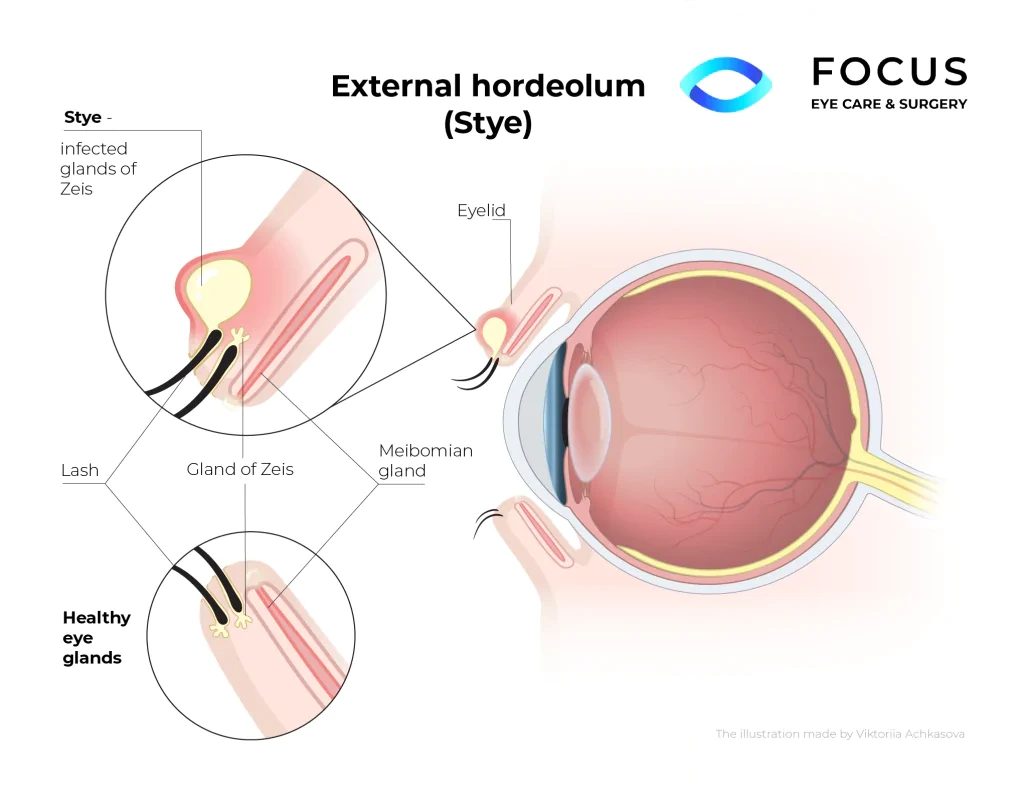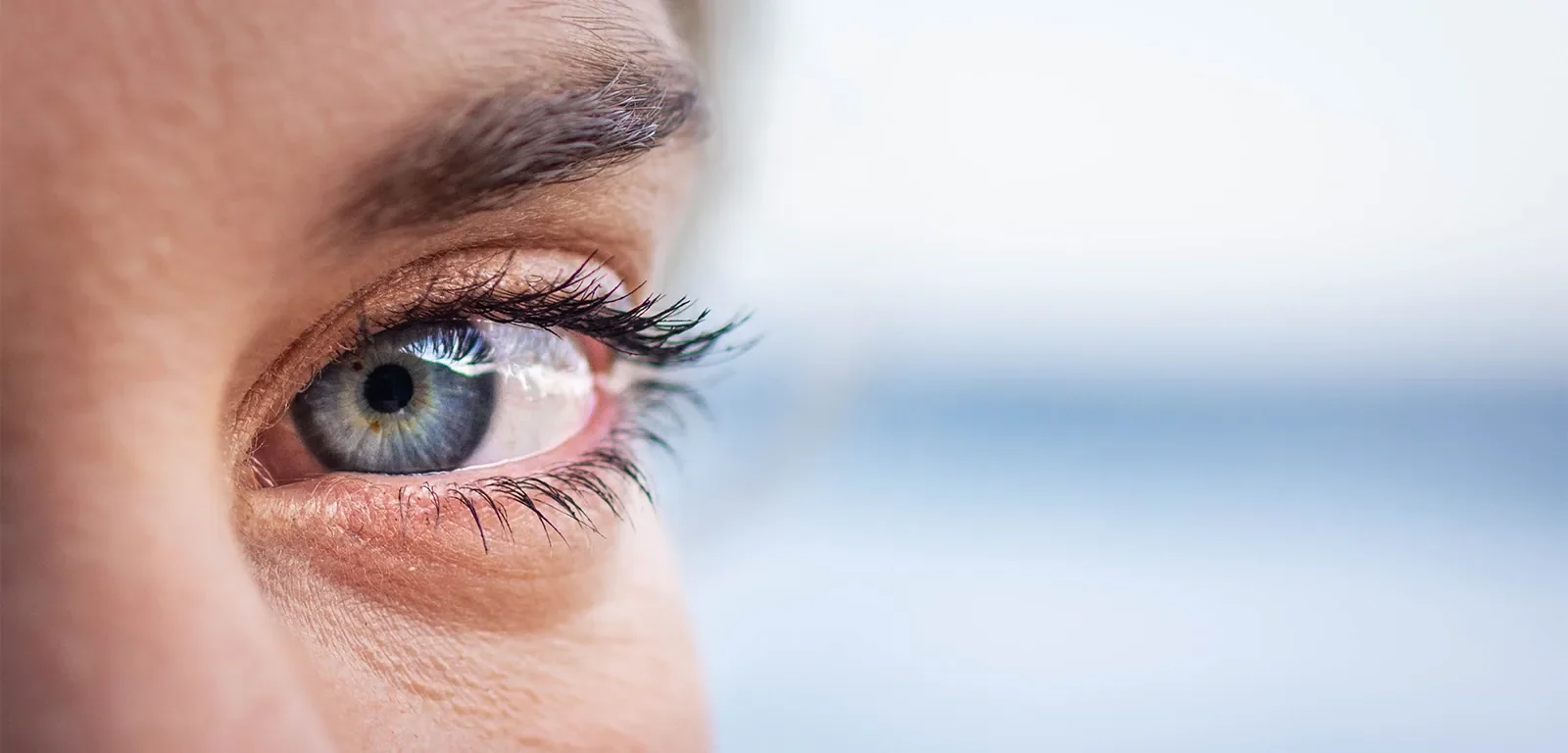
Stye
Stye
What is a Stye?
A stye is a reddish, painful bump in or along the eyelid. It develops when the oil gland or hair follicle on the eyelid gets clogged and infected. Styes are fairly common and can occur at any age. In most cases, styes resolve on their own without the need for any treatment. However, if it doesn’t dissolve naturally even after one week, then an eye care specialist must be consulted.
A stye, also called sty or hordeolum, usually occurs in one eye but can occur in both eyes. Based on its location on the eyelid, it is divided into two types:
External stye: These are the most common type of styes that occur on the outer edge of either the upper or lower eyelid. External styes occur due to clogged and infected hair follicles, sebaceous (Zeis) glands, or apocrine (Moll) glands.
Internal stye: Internal styes develop on the inside of an eyelid. These occur due to clogged and infected oil glands (meibomian glands) in the eyes.



A stye is usually caused by a bacterial infection, most commonly a Staphylococcal infection, of the clogged oil gland or hair follicle of the eyelid.
Styes are incredibly common as these can occur to anyone irrespective of age or gender. However, certain conditions can increase the risk of developing styes, such as:
- Blepharitis (a condition that affects the eyelids)
- Seborrheic dermatitis or acne rosacea
- Diabetes or other medical conditions
- History of a stye in the past
- Used or expired makeup products
- Leaving eye makeup on overnight
- Dirty contact lenses or lack of hand hygiene while using contact lenses
- Sleep deprivation
- Poor nutrition
- Poor sanitation
- Frequent eye rubbing
Prevention of Stye
Although styes can occur on anyone at any time, there are ways to prevent these painful bumps from developing, such as:
Proper hand hygiene: Practice handwashing with warm water and anti-bacterial soap and/or an alcohol-based sanitizer. Avoid touching eyes unnecessarily.
Manage cosmetic products: Avoid using used or expired cosmetics, don’t share your cosmetics with others, and make sure to remove makeup before going to bed.
Use clean contact lenses: Make sure the contact lenses are clean and disinfected before you use them, and only handle those lenses with thoroughly washed, clean hands.
Warm compress: If you have a history of a stye in the past, it’s better if you practice regular warm compress to prevent recurrent infections.
Manage blepharitis and other medical conditions: If you suffer from blepharitis or other medical conditions, then you should consult your doctor and get it treated.
Symptoms of Stye in Your Eyes
The symptoms associated with a stye include the following:
- A painful red lump that appears similar to acne
- Swollen eyelid
- Eyelid pain
- Redness and tenderness
- Crusting of eyelids margin
- Droopy eyelid
- Itching of the eye
- Blurred vision
- Mucus like eye-discharge
- Tearing
- Blinking discomfort
- Burning or foreign body sensation in the eye
- Photosensitivity
Diagnosis of Stye
A stye is diagnosed clinically, often just by looking at the eyelid. A light and magnifying device can be used for a thorough examination of the eyelid

Treatment for Styes
Styes aren’t usually a cause of serious concern and are mostly self-remitting without any need for professional care. However, if the stye persists for more than two weeks or affects vision, then medical attention should be sought immediately. Some ways to treat styes are listed below:
Warm compresses: Hold a clean cloth soaked in hot water for 10–15 minutes at a time, multiple times a day, for pain relief and quick recovery from the stye.
Analgesics: As stye can be very painful, painkillers such as acetaminophen or NSAIDs can provide symptomatic relief.
Antibiotics: Although the efficacy of topical antibiotics isn’t well-established, your ophthalmologist may prescribe a topical ointment or eye drops like erythromycin for fast relief and recovery. If the infection spreads elsewhere, they might prescribe oral antibiotics.
Incision and drainage: This may be necessary in cases where the stye doesn’t seem to improve 48 hours after starting warm compresses.
Surgery: A stye surgery is the last resort in stye treatment and may be done if it doesn’t resolve after any other treatment modalities and creates vision impairments. An ophthalmologist will perform the procedure, generally under local anesthesia.
Complications of Styes
Although styes are usually self-remitting and complications associated with stye are extremely rare, these can lead to a few conditions, such as:
Meibomian cyst: Meibomian glands are small glands of eyelids that are responsible for the production of sebum that lubricates the eye. A persistent stye can block this gland and lead to the formation of a meibomian cyst. However, this can be treated easily.
Preseptal or periorbital cellulitis: If the infection spreads to the surrounding tissues of the eye, then it can lead to inflammation of the layers of skin around the eye. It causes red, swollen eyelids and periorbital area. It can be treated with antibiotics.
Chalazion: A persistent stye most commonly develops into a chalazion. It is a painless lump on the eyelid that can eventually enlarge in size to create vision difficulties, swollen eyes, cosmetic deformity, corneal irritation, and often needs surgical removal.

Faqs About Stye
A stye is very common, affecting anyone regardless of age, race, or gender.
A stye will generally last one to two weeks.
A stye often resolves on its own without any specific treatment. However, if it doesn’t dissolve spontaneously, one might need to seek medical assistance for further management.
Signs and symptoms associated with styes include:
– Painful, red bumps in, on, or outside the eyelids
– Crusting of the margin of the eyelids
– Tearing Pain and swelling of the eyelids
– Itchiness and foreign body sensation in the eye
– Sensitivity to light.
Styes aren’t usually contagious. However, bacteria can spread to your hands if you keep touching these bumps. Hence, it’s extremely important to practice hand hygiene before and after touching the stye. Pillowcases and face towels should also be washed to limit the bacteria from spreading. Avoid repetitive touching or rubbing of the eyelids except for warm compression or medicine application.
A stye isn’t contagious, and one can continue their daily activities, work, or school even while having styes.
Styes are very common infections of the eyelids and can occur on anyone. However, certain conditions might put you at a greater risk of developing these bumps, such as: Blepharitis or inflammation of the eyelid Poor sanitation and hand hygiene Dirty contact lenses and lack of hand hygiene before putting them on Used, shared, or expired makeup products Overnight eye makeup products Skin conditions such as seborrheic dermatitis or acne rosacea Medical conditions such as diabetes or immunocompromised patients
The following things are to be kept in mind while treating the stye.
Dos
– Warm compresses
– Clean eyelids
Don’ts
– Squeeze or pop the stye
– Wear contact lenses or makeup until the stye dissolves
– Rub or repetitively touch the eyelids
Consult a doctor immediately if: The stye doesn’t show any improvements even after starting warm compression You experience visual difficulties Your eye is swollen and the pain keeps increasing Pus or blood is leaking from the stye The eyelid is hot In case of recurrent styes Your doctor may prescribe you topical antibiotic eye drops or ointment for faster relief and recovery, or oral antibiotics if the infection has spread to the surrounding areas. If the conservative ways fail to treat the stye, your doctor may opt for incision and drainage or surgical removal of the stye.
There are ways that can help to prevent the formation of stye, such as: Practice good hand and facial hygiene Avoid used, shared, and expired cosmetic products Always remove makeup before bedtime Use clean and disinfected contact lenses, and practice good hand hygiene before and after using them


Are You a Candidate for
Vision Correction?
Whether you just need a general eye exam, or if you are interested in reducing or eliminating your need for glasses or contacts, our team is here to help! Contact us to book an appointment today!
The doctors at Focus Eye Care & Surgery have reviewed and approved this content.
Page Updated:


